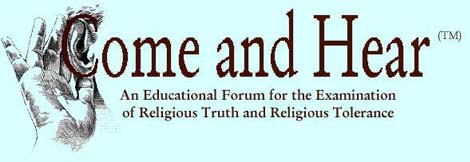Censoring the Talmud
2. Jesus' Membrum in the Talmud
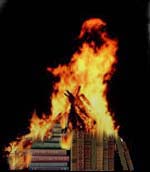
Censorship damages inter-religious and inter-cultural understanding — no matter who does it.
| Navigate This Site | |
 | |
| Home | |
| Valentine | |
| Dilling | |
| Talmud | |
| The Rabbis | |
| Supplement | |
| Glossary | |
| Download | |
| Admin | |
| | |
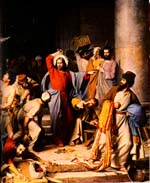
Jesus Cleansing the Temple
And [Jesus] found in the temple those that sold oxen and sheep and doves, and the changers of money sitting: And when he had made a scourge of small cords, he drove them all out of the temple, and the sheep, and the oxen; and poured out the changers' money, and overthrew the tables; And said unto them that sold doves, Take these things hence; make not my Father's house an house of merchandise. (John 2:14-16)
The incident exemplifies the antagonism that existed between Jesus and the Priests and Pharisees during Jesus' lifetime, and the antagonism that is reflected in both the Talmud and the New Testament, as they exist today.
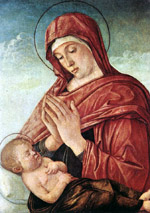
Mary, mother of Jesus. According to the Talmud:
R. Papa observed: This is what men say, 'She who was the descendant of princes and governors, played the harlot with carpenters.' Did the children of Israel slay with the sword among them that were slain by them. Rab said: They subjected him to four deaths, stoning, burning, decapitation and strangulation. — Sanhedrin 106a - 106b

The Koran on Mary, mother of Jesus:
Behold! the angels said:
"O Mary! God giveth thee
Glad tidings of a Word
From Him: his name
Will be Christ Jesus,
The son of Mary, held in honor
In this world and the Hereafter
And of (the company of) those
Nearest to God;
"He shall speak to the people
In childhood and in maturity.
And he shall be (of the company)
Of the righteous."
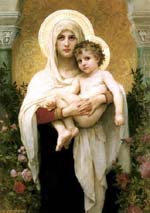
She said: "O my Lord!
How shall I have a son
When no man hath touched me?"
He said: "Even so:
God createth
What he willeth:
When He hath decreed
A Plan, He but saith
To it, 'Be,' and it is!"
— Qur'an Translation: Surah (Chapter) 3, verses 45-47

Pope Innocent III in a long decree stated: that Jews are "not to be killed by anyone [but], they are to us dangerous as the insect in the apple, as the serpent in the breast … Since, therefore, they have already begun to gnaw like the rat, and to stink like the serpent, it is to our shame that the fire in our breast which is being eaten by them, does not consume them … Although Christian piety tolerates the Jews … and allows them to continue with us, although the Moors will not tolerate them, they must not be allowed to remain ungrateful to us in such a way as to repay us with contumely, for favors, and contempt for our familiarity. They are admitted to our familiarity only through our mercy …" (9)
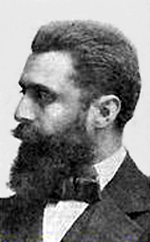
Theodore Herzl, Hungarian lawyer of the 19th Century and founder of modern Zionism, apparently considered the great experiment — the attempt to create compatibility between Jews and people of other religions — a failure.
"The solution is Exodus, the gathering together of the people out of dispersion — their concentration in a land of their own, under their own government, responsible to themselves." — Herzl (23)

Deborah Lipstadt is a professor of modern Jewish and Holocaust studies at Emory University. She also works with the U.S. Holocaust Memorial Museum.
"In truth, that without the anti-Judaism — much of it anti-Semitism — of the New Testament, or at least in the way the New Testament has been interpreted and taught, there would have been no Nazism, and there would have been no Holocaust. I'm not saying that it was inevitable, but it is a direct outgrowth." — Lipstadt (36)
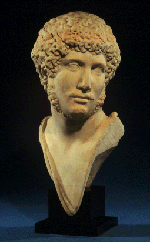
Hadrian, "Emperor of the Roman World Empire from 117 A.D. to his death, 138 A.D. In 132 A.D. the Jews began a revolt, and for four years carried on a bloody war." — Elizabeth Dilling (3)
"One of the causes of the great revolt against the Romans at this time was the prohibition by the Roman government of the study of the Torah [Talmud] … [Hadrian] decreed that if any of the old rabbis should qualify a young rabbi … both should be put to death …" — Rabbi Rodkinson (7)

Pope John Paul II with the Chief Rabbi of Kiev.
"Although Christianity was the enemy of Jews and Judaism for nearly two millennia, times have changed. The Vatican, under the current pope, a true friend of the Jewish people, has granted diplomatic recognition to the State of Israel, and Christian fundamentalists in the United States are among the State of Israel's most trusted backers." — Rabbi Shmuley Boteach (16)
Surely the most inflammatory attacks on the Pharisees in the New Testament are attributed to Jesus. Elizabeth Dilling, for example, begins her book with the following:

| Bible scholars are aware that Jesus Christ denounced the Pharisees. He said they nullified all the Commandments of God by their Tradition, "teaching for doctrines the commandments of men" (Mark 7:13; Matt. 15:6-9, etc.). His invective, in truth, cannot be equalled. All of Matthew 23 is like a whiplash. He likened Pharisaism to a whited sepulchre, indeed beautiful outwardly, but "inside full of dead men's bones and of all uncleanness." Christ climaxed one condemnation after another with the expletive, "Hypocrites!" He called the Pharisees children of them that killed the Prophets. He foretold they would go on killing, crucifying and persecuting until the guilt for all the righteous blood shed from Abel on down would be upon them. "Ye serpents, ye generation of vipers, how can ye escape the damnation of hell?" Christ asked. | |

As the Catholic Church distances itself from Jesus' teachings, will this pope or a successor rule that the Gospels have been wrongly translated? That Jesus was misquoted? Or that Jesus mis-spoke, and has since retracted and apologized for his remarks?
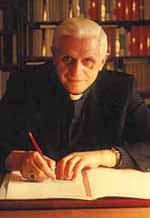
Joseph Cardinal Ratzinger, Prefect of the Congregation for the Doctrine of the Faith of he Roman Catholic Church and author of Many Religions-One Covenant: Israel, the Church, and the World. Cardinal Ratzinger writes:
"The history of the relationship between Israel and Christendom is drenched with blood and tears. It is a history of mistrust and hostility, but also — praise be to God — a history marked again and again by attempts at forgiveness, understanding and mutual acceptance." — Cardinal Ratzinger (31)
Cardinal Ratzinger is in an excellent position to ask the Chief Rabbis of Israel and elsewhere if it is really true that Jesus practiced magic with his membrum. If the rabbis answer in the affirmative, Cardinal Ratzinger will doubtlessly want to make changes in Catholic doctrine.
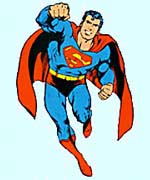
You can help in the battle for Truth, Justice, and the American Way! Fight the forces of censorship and suppression of the Talmud, and bring about understanding between peoples of different faiths.
Download this site to your desktop computer.
Make CDs and distribute them to friends, neighbors, ministers, and community leaders.
Email your favorite essay to your email list.
Post your favorite essay to discussion forums.
Print your favorite essays and give them to those not on the Internet.
Flyers advertising Come-and-Hear.com can be distributed throughout your community.
 Genuine Come and Hear™ CDs do not contain executable programs. When making CDs, do not include any files that end in .exe, .com, .bat, .vbs, .doc, .pif, .sit, or .scr. The person receiving the CD should use his own browser to view the files. This helps to protect him from harmful programs and viruses.
Genuine Come and Hear™ CDs do not contain executable programs. When making CDs, do not include any files that end in .exe, .com, .bat, .vbs, .doc, .pif, .sit, or .scr. The person receiving the CD should use his own browser to view the files. This helps to protect him from harmful programs and viruses.
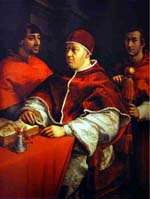
Pope Leo X was the son of Lorenzo the Magnificent of the House of Medici. He assumed the Throne of Peter in 1513. "There is only praise for the Medici Popes in Jewish literature and only disappointment about the condition of Jewry during the Reformation and afterwards, for the succeeding Popes drove the Talmudists out of Vatican circles and back into the ghetto." — Elizabeth Dilling (4)
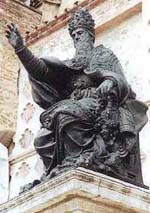
Pope Julius III (fresco (8)) sat on the Throne of Peter from 1550 to 1555. This statue was commissioned in 1555 by the city of Perugia in gratitude to his Holiness for granting the city its independence, which had been taken away by the previous pope. (11) "Upon the denunciation of the baptized Jews Ananel di Foligno, Joseph Moro, and Vittorio Eliano, Julius issued (Aug. 12, 1553) an edict enjoining the bishops and magistrates to seize and burn all copies of the Talmud, as containing slanderous attacks against Christianity. With premeditated malice this edict was to be carried into effect on the day of the Jewish New-Year (Sept. 9, 1553). In the following year (May 29) Julius issued the bull "Contra Hebræos Retinentes Libros Thalmudis," in which the Jews were ordered, on pain of severe punishment, to give up within four months all books supposed to contain blasphemies against Jesus; such books to be revised by Christian censors, and the suspected passages expunged." — Jewish Encyclopedia (4)

Martin Luther spoke of the Jews in his last sermon: "You, Milords and men of authority, should not tolerate but expel them. They are our public enemies and incessantly blaspheme our Lord Jesus Christ; they call our blessed Virgin Mary a harlot and Her Son a bastard … if they could kill us all, they would gladly do so; in fact many of them murder Christians, especially those professing to be surgeons and doctors. They know how to deal with medicaments in the manner of the Italians — the Borgias and Medicis — who gave people poison which brought about their death in one hour or a month … As a good patriot I wanted to give you this warning for the very last time to deter you from participating in alien sins. You must know I only desire the best for you all, rulers and subjects."

Rabbi Daniel Lapin, an Orthodox rabbi and author of America's Real War, states that Jews and Christians should work together and recognize their common values. America's real war, according to the dust jacket, is being fought between those who want a secular nation and those who want "a spiritual America."
Rabbi Lapin is president of Toward Tradition. His web page states: "… Rabbi Lapin has written for the Wall Street Journal, National Review, Commentary, the American Enterprise, and the Washington Times, and has had speaking engagements for the Christian Coalition, U.S. Army, Harvard Law School, and the Family Research Council. He … was recently appointed to a U.S. presidential commission."
Rabbi Lapin presents himself as a friend of the Christian Right, and is a favorite speaker of such organizations as Concerned Women for America. His America's Real War is aimed at a conservative Christian readership. Chapter Six is entitled "The Curious Rise of Anti-Christianism."
Rabbi Lapin expresses shock and dismay that liberal Jews attack Christianity, giving the impression that Orthodox Jews, like Rabbi Lapin, do not attack Christianity. However, we find that the Orthodox wing of Judaism advocates the Noahide Laws, defines Christianity as idolatry, and calls for decapitation of idolaters (see America's New Government Church, What About Gentiles?). This includes in particular the Orthodox Hassidic rabbis.
According to his own words, Rabbi Lapin spent "many years of study at the theological academy (yeshiva) of Kfar Hassidim in Israel." (27) He comes from a family of rabbis; his two brothers are rabbis, his father was a rabbi, his uncles and cousins taught Talmud at the Gateshead Talmudic Academy in England. (28) Rabbi Lapin is a disciple of his great uncle, the Hassidic rabbi Eliyahu Lapian, whose works are in the Chabad Lubavitch library in Brooklyn, New York. (29) Rabbi Eliyahu Lapian is featured on the Union of Orthodox Jewish Congregations of America web site exhibit, "Great Leaders of Our People." (30)
Hence, given his background, Rabbi Lapin could not fail to know about this aspect of the Talmud, particularly in light of his close ties with the Hassidic movement. Perhaps a lifetime habit of self-censorship has attenuated his message. (10)
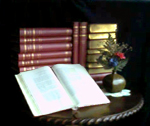
The Soncino Talmud was translated by world-renowned Talmud and Hebrew/Aramaic scholars. It was the first complete English translation ever published, and it has been the standard, commonly accepted rabbi-approved English translation for more than six decades.
Accolades for Soncino. Praise for the Soncino Talmud appears on the dust jacket of the 1961 Edition:
"The rendering is accurate and scholarly … In particular the translators deserve praise for their choice of suitable equivalents for technical terms and phrases that are difficult to turn into another language." — The Times Literary Supplement
"… this translation of the Talmud will open up for the English speaking readers the most varied and indispensable index to the collective wisdom of the post-Biblical Hebrew mind, and afford direct knowledge of the ordinances which have governed and continue to govern the religious institutions and social polity of the Jewish people." — the late Rabbi Dr. A. Feldman, Dayan of the Beth Din, London
"I offer my heartiest congratulations to all who have worked together in producing this translation of the Talmud into English. They have dealt with the enormous difficulties of their tasks with remarkable skill." — The Rev. Dr. R. Travers Herford, author of Christianity in Talmud and Midrash and Talmud and Apocrypha
"The Editor, Dr. Isidore Epstein, and his band of scholars have produced a translation which is a marvel of skill in dealing with the formidable difficulties which the Talmud presents." — The Jewish Chronicle
"The Soncino Talmud is … an adornment for any library, a hallmark of intelligent Jewishness in a family … an unfailing source of inspiring information to the students of every creed and race." — Jewish Forum
"It [the Soncino Talmud] will have value for Gentile as well as Jewish scholars." — The Manchester Guardian
"These volumes are magnificently produced, and will assuredly take their place among the monuments of modern scholarship." — The Yorkshire Post
For an attestation to the usefulness of the Soncino Talmud General Index, see the Very Rev. the Chief Rabbi Dr. Israel Brodie's Foreword. (18)
There is no doubt that Jesus of Nazareth and the Pharisees had a violent dislike for each other. This point has been a delicate one between Jews and Christians ever since. The tension, however, provides a good object lesson on the use of euphemisms and code words used in the Talmud to censor or obscure the meaning of the text.
(Unless otherwise indicated, in the following excerpts we have omitted the Soncino footnotes. To study the footnotes and the full context, follow the link below the excerpt.)
Let us look at this short excerpt from Tractate Sanhedrin. Speaking of a character called "Balaam," a Sage states:
GEMARA. … He practised enchantment by means of his membrum.
— Babylonian Talmud, Tractate Sanhedrin 105a
Soncino 1961 Edition, page 717
What Is a Membrum?
"Membrum" is not an English word. It is the Latin root of the English word "member." However, "membrum" is used in so many contexts by the Soncino translation team, perhaps we can puzzle out the meaning by examining the contexts:
R. Jose, while boasting of his modesty to the other Sages, remarks:
GEMARA. … R. Jose said: I have never looked at my circumcised membrum.
— Babylonian Talmud, Tractate Shabbath 118b
Soncino 1961 Edition, page 583
During a discussion of forbidden sexual relations, the Sages debate the exact point in the process that a brother dishonors his sister:
GEMARA. … Now, this agrees with the view that the first stage [which dishonors her] is contact with her sexual organ; but on the view that the first stage is the insertion of the membrum, what can you say?
— Babylonian Talmud, Tractate Sanhedrin 73b
Soncino 1961 Edition, page 499
During a discussion of the death penalty for stubborn and rebellious adolescent boys, the Sages consider when boys are too young for execution.
GEMARA. … R. Hiyya taught: Until he grows a beard round the corona. When R. Dimi came, he explained it thus: It means, until the hair surrounds the membrum, but not until it grows round the testicles.
— Babylonian Talmud, Tractate Sanhedrin 68b
Soncino 1961 Edition, page 466
Here, the Sages are discussing sex with a female slave, with a married woman in adultery, and a sotah, (a married woman under suspicion of adultery). (The ellipsis in this Gemara indicates non-germane text has been omitted. To see the full text, follow the link at the end of the excerpt.)
GEMARA. … Raba said: For what purpose did the All Merciful write 'carnally' in connection with the designated bondmaid, a married woman, and a sotah? … That in connection with a married woman excludes intercourse with a relaxed membrum. This is a satisfactory interpretation in accordance with the view of him who maintains that if one cohabited with forbidden relatives with relaxed membrum he is exonerated.
— Babylonian Talmud, Tractate Yebamoth 55b
Soncino 1961 Edition, page 371
This is a special definition of cohabitation. (14) And later in the same folio:
GEMARA. … R. Shesheth raised an objection: 'Carnally implies that guilt is incurred only when intercourse was accompanied by friction'; does this not refer to friction of the membrum! — No; friction of the corona.
— Babylonian Talmud, Tractate Yebamoth 55b
Soncino 1961 Edition, page 373
The Sages in this passage are discussing how a man should conduct his daily toilet in order to avoid touching his membrum. In the following, terumah means a Temple offering to be eaten by the priest.
GEMARA. … If a priest, while eating terumah, felt a shiver run through his body he takes hold of his membrum and swallows the terumah. 'Takes hold'! But has it not been taught: R. Eliezer said, 'Whoever holds his membrum when he makes water is as though he had brought a flood on the world'? To this Abaye replied. 'With a thick rag'. Raba replied: It may even be said to apply to a soft rag for once the semen has been detached the subsequent touch does no longer matter. And Abaye? — He made provision against the possibility of an additional discharge. And Raba? — He does not consider the possibility of any additional discharges. But does he not, seeing that it was taught, 'To what may this be compared? To the putting of a finger upon the eye where, as long as the finger remains on it, the eye continues to tear'? Now Raba? — It is quite uncommon for one to get heated twice in immediate succession.
[Reverting to] the main text: 'R. Eliezer said, Whoever holds his membrum when he makes water is as though he had brought a flood on the world'. But, they said to R. Eliezer, would not the spray bespatter his feet and he would appear to be maimed in his privy parts so that he would be the cause of casting upon his children the reflection of being illegitimate?
— Babylonian Talmud, Tractate Niddah 13a
Soncino 1961 Edition, page 85
Later in the text:
GEMARA. … Rab Judah and Samuel once stood upon the roof of the Synagogue of Shaf-weyathib in Nehardea. Said Rab Judah to Samuel 'I must make water'. 'Shinena', the other replied, 'take hold of your membrum and make the water outside [the roof]'. But how could he do so, seeing that it was taught: R. Eliezer said, Whoever holds his membrum when he makes water is as though he brought a flood on the world?
— Babylonian Talmud, Tractate Niddah 13a
Soncino 1961 Edition, pages 86-87
At this point it is probable that we have a sufficient number of contexts to discern the meaning of "membrum." Let's move on.
Who Is Balaam?
Now, who was Balaam who "practised enchantment by means of his membrum"? Originally, the Old Testament Balaam was a prophet from the heathen tribes who was hired to curse the Israelites on their journey from Egypt (Numbers 22-24). Balaam refused that commission, blessing the Israelites instead. Later, he earned the wrath of the Israelites and was slain by them (Numbers 31:8). Mention of Balaam occurs thereafter in the Books of Deuteronomy, Joshua, Nehemiah, and Micah, sometimes as a wicked man, sometimes as good.
In the opinion of many modern rabbinical scholars, "Balaam" was often used by the Sages as an alias or code word for Jesus of Nazareth. For example, consider this statement about Balaam from the prestigious Jewish Encyclopedia:
Henceforth he became the type of false prophets seducing men to lewdness and obscene idolatrous practices (Rev. ii. 14; II Peter ii. 15; Jude 11; Abot. v. 19). The name 'Nicolaitanes,' given to the Christian heretics 'holding the doctrine of Balaam' (Rev. ii. 6, 15), is probably derived from the Grecized form of Balaam, [Hebr. char.] = [Greek char.], and hence also the pseudonym given to Jesus in Sanh. 106b and Git. 57a.
— The Jewish Encyclopedia (1) (emphasis added)
The Jewish Encyclopedia's article on Jesus contains much information about various pseudonyms used for Jesus in the Talmud, including "Balaam," "son of Pandera," and "Ben Stada."
Why would the Sages use a code word for Jesus of Nazareth? Perhaps to avoid confrontations with the Christian establishment. By disguising unflattering remarks about Jesus, only those inside the circle of Talmud believers would understand; Christians, if they ever saw the material, would miss the significance. An example is given by Rabbi Rodkinson in his book, The History of the Talmud. In 1239 A.D., Jewish apostates brought charges in Rome that the Talmud contained sacrilegious sayings about Jesus and His mother. Rabbi Jechial answered the charges (in part) by denying that the Talmud contained any mention of Jesus of Nazareth:
To the other accusations of Donin, that the Talmud terms the followers of Jesus Christ "Minim" (infidels), that it condemns Jesus, that it allows ill-usage of people of other nationalities, etc., he [Rabbi Jechial] replied: "In the Talmud there is no mention of Jesus (Jesu) Christ, but only of another Jesus (Jeshua) who was a disciple of R. Joshua b. Prachia, who lived two hundred years before Christ."
— Rabbi Rodkinson (2)
Balaam's Mother a Harlot, Sanh. 106a, 106b
In Tractate Sanhedrin 106a and 106b, the Sages discuss Balaam and his mother. We get another clue about Balaam's identity with the hint that Balaam's mother "played the harlot with carpenters."
GEMARA. … Balaam also the son of Beor, the soothsayer, [did the children of Israel slay with the sword]. A soothsayer? But he was a prophet! — R. Johanan said: At first he was a prophet, but subsequently a soothsayer. R. Papa observed: This is what men say, 'She who was the descendant of princes and governors, played the harlot with carpenters.' (5) [106b] Did the children of Israel slay with the sword among them that were slain by them. Rab said: They subjected him to four deaths, stoning, burning, decapitation and strangulation.
— Babylonian Talmud, Tractate Sanhedrin 106a - 106b
Soncino 1961 Edition, page 725
In a footnote, Rabbi Dr. H. Freedman promotes scholar Rev. Dr. Herford's view that the "harlot" is a reference to Mary, mother of Jesus.
- Herford, Christianity in the Talmud, p. 48, suggests that Balaam is frequently used in the Talmud as a type for Jesus … Though no name is mentioned to shew which woman is meant, the mother of Jesus may be alluded to, which theory is strengthened by the statement that she mated with a carpenter.
— Rabbi Dr. Freedman
It is of course, impossible for any man to undergo "four deaths" as told in Sanhedrin 106b, above. This detail does not aid in the identification. It may, however, express the fate that the Sages thought "Balaam" deserved. (Rabbi Michael Rodkinson omits that passage in Sanhedrin 106a without footnote or comment. See Do Not Censor the Talmud, Please "Appendix B: Rabbi Rodkinson's Censored Talmud," for discussion and cites.)
"Balaam Being Used As an Alias for Jesus"
Sanhedrin 106b continues. A Sage is asked a question about Balaam by a min. According to the Soncino Talmud Glossary, min is the Talmud word for Christian. That a min is asking after the details of Balaam's life is a further clue to the identity of that character. In the Soncino Talmud, this paragraph follows immediately on the paragraph quoted above.
GEMARA. … A certain min said to R. Hanina: Hast thou heard how old Balaam was? — He replied: It is not actually stated, but since it is written, Bloody and deceitful men shall not live out half their days, [it follows that] he was thirty-three or thirty-four years old. He rejoined: Thou hast said correctly; I personally have seen Balaam's Chronicle, in which it is stated, 'Balaam the lame was thirty years old when Phinehas the Robber killed him.' (11)
— Babylonian Talmud, Tractate Sanhedrin 106b
Soncino 1961 Edition, page 725
Rabbi Dr. H. Freedman, translator, does not explain why a Christian would ask the Pharisee about Jesus, but he interprets this passage as follows:
- According to the view that all the Balaam passages are anti-Christian in tendency, Balaam being used as an alias for Jesus, Phinehas the Robber is thus taken to represent Pontius Pilatus, and the Chronicle of Balaam probably to denote a Gospel (v. Herford op. cit. 72ff.).
— Rabbi Dr. Freedman
The interpretation that "Balaam" is Jesus is persistent, but the denial is also persistent. In February 2003, the Anti-Defamation League of B'nai B'rith issued a position paper entitled The Talmud in Anti-Semitic Polemics. (17) Naming the Soncino as a preferred translation (on page 13), the ADL states (on page 12):
Jesus and Balaam
To agitate Christian readers, anti-Talmud writers often attempt to portray the Talmud as demeaning the figure of Jesus. In the opinion of most scholars, the Talmud only refers to Jesus in a handful of places, and though these references may not reflect the courteous ecumenicism of the modern world, neither are they particularly inflammatory. But the Talmud bears much harsher animus towards the biblical figure of Balaam, the pagan magician who sought to curse the Jews as they traveled through the desert after the Exodus from Egypt. Rabbinic tradition ascribes other crimes to Balaam as well, and in various places describes some of the punishments he may have suffered after his death. In the nineteenth century, when the field of academic Jewish studies was in its infancy, a small group of Jewish scholars suggested that in some cases the term Balaam in the Talmud may be a codeword for Jesus. Though later scholars showed that this suggestion could not be true (for reasons pertaining to the context of the Balaam references and the lack of manuscript variants substituting Jesus for Balaam), anti-Semites have ever since claimed that the true hatred that Judaism possesses for Christianity is expressed in these coded expressions against Balaam found in the Talmud.
— Anti-Defamation League (17) (emphasis added)
Let us consider the following points. The ADL states:
- "In the nineteenth century, when the field of academic Jewish studies was in its infancy …" — Jewish studies has been out of its infancy for more than 2,000 years. Since the time of Ezra the Scribe in about 400 B.C., the study of Jewish Scriptures by Jews has not ceased. Hillel, Akiba, and Judah HaNasi (Judah the Prince) lived almost 2,000 years ago and are still considered the giants of Jewish studies.
- Not all those "nineteenth century" scholars were nineteenth century scholars — the Jewish Encyclopedia was published 1901-1906, Rev. Dr. Herford's Christianity in the Talmud and Midrash was published in 1903, and the Soncino Talmud was published between 1935 and 1948. Those of the Soncino would be more accurately described as twentieth century scholars.
- "… a small group of Jewish scholars …" — The scholars who suggest that Balaam refers to Jesus were not a "small group." They include:
- the Soncino editor Rabbi Dr. Epstein of Jews' College, London
- Rabbi Dr. Freedman and Jacob Shachter, the renowned Talmud scholars who translated Tractate Sanhedrin for Dr. Epstein and the Soncino Press
- the writers and editors of The Jewish Encyclopedia
- the Rev. Dr. Robert Travers Herford, author of Christianity in the Talmud and Midrash, a renowned Jewish studies scholar of his day
- Not all the "Jewish scholars" were Jewish. The Rev. Dr. Robert Travers Herford, cited by Soncino translator Rabbi Dr. Freedman, was a unitarian Gentile, though well respected among Jewish scholars. Rev. Dr. Herford's endorsement of the Soncino Talmud is printed on the Soncino dust jacket.
Given that the ADL uses patently untrue premises in its argument, how reliable is the ADL's conclusion — that Balaam is not Jesus?
That the ADL accepts the Soncino Talmud, but selectively rejects the Soncino scholarship on the Balaam references is significant. It indicates that, to the ADL and the public they are addressing, those passages are politically sensitive. It is apparently important to the ADL to assert that the Talmud is not hostile to Christianity, so important that ordinary rules of scholarship may be bent in the assertion.
This, too, is a form of censorship. Given the legal clout of the ADL and the readiness with which it blackens reputations with the "anti-Semitic" label, scholars in these matters are not free to draw conclusions according to the rules of scholarship. Instead, with the constant threat that statements considered unfavorable to the Talmud will result in punishment of the scholar, scholars are driven by political concerns to draw the "correct" conclusions and censor their own work. See further discussion of the freedom of scholarship in Appendix: Deborah Lipstadt Finds Anti-Semitism in the New Testament
Balaam's Membrum, Sanh. 105a, 105b
In the last Soncino footnote we cited, Rabbi Dr. Freedman quotes Rev. Dr. Herford that Balaam is "frequently used in the Talmud as a type for Jesus." This agrees with the view of the writers and editors of The Jewish Encyclopedia: "Balaam" is used in multiple places in the Talmud as pseudonym for Jesus.
In the next passage, Balaam limped on one foot, was blind in one eye, practiced enchantment by means of his membrum, and committed bestiality with his ass. Elizabeth Dilling understood this passage to be about Jesus, and certainly we could not fault her or anyone else who interprets it in that way. (24)
GEMARA. … R. Johanan said: Balaam limped on one foot, as it is written, And he walked haltingly. Samson was lame in both feet, as it is written, [Dan shall be a serpent by the way,] an adder in the path that biteth the horse's heels. Balaam was blind in one eye, as it is said, [and the man] whose eye is open … He practised enchantment by means of his membrum. For here it is written, falling, but having his eyes open; whilst elsewhere is written, And Haman was fallen on the bed whereon Esther was.
It was stated, Mar Zutra said: He practised enchantment by means of his membrum. Mar the son of Rabina said: He committed bestiality with his ass. The view that he practised enchantment by means of his membrum is as was stated. The view that he committed bestiality with his ass [is because] here it is written, He bowed, he lay down as a lion and as a great lion; whilst elsewhere it is written, At her feet he bowed, he fell.
— Babylonian Talmud, Tractate Sanhedrin 105a - 105b
Soncino 1961 Edition, page 717
Jesus Was a Magician
According to The Jewish Encyclopedia, Jesus was often accused by the Talmudists of performing magic.
It is the tendency of all these sources to belittle the person of Jesus by ascribing to him illegitimate birth, magic, and a shameful death …
Magic may have been ascribed him over against the miracles recorded in the Gospels …
The sojourn of Jesus in Egypt is an essential part of the story of his youth. According to the Gospels he was in that country in his early infancy, but Celsus says that he was in service there and learned magic …
According to Celsus (in Origen, “Contra Celsum,” i. 28) and to the Talmud (Shab. 104b), Jesus learned magic in Egypt and performed his miracles by means of it; the latter work, in addition, states that he cut the magic formulas into his skin. It does not mention, however, the nature of his magic performances (Tosef., Shab. xi. 4; Yer. Shab. 18d); but as it states that the disciples of Jesus healed the sick “in the name of Jesus Pandera” (Yer. Shab. 14d; Ab. Zarah 27b; Eccl. R. i. 8) it may be assumed that its author held the miracles of Jesus also to have been miraculous cures. Different in nature is the witchcraft attributed to Jesus in the “Toledot.” When Jesus was expelled from the circle of scholars, he is said to have returned secretly from Galilee to Jerusalem, where he inserted a parchment containing the “declared name of God” (“Shem ha-Meforash”), which was guarded in the Temple, into his skin, carried it away, and then, taking it out of his skin, he performed his miracles by its means. This magic formula then had to be recovered from him, and Judah the Gardener (a personage of the “Toledot” corresponding to Judas Iscariot) offered to do it; he and Jesus then engaged in an aerial battle (borrowed from the legend of SIMON MAGUS), in which Judah remained victor and Jesus fled.
The accusation of magic is frequently brought against Jesus. Jerome mentions it, quoting the Jews: “Magum vocant et Judaei Dominum meum” (“Ep. 1v., ad Ascellam,” i. 196, ed. Vallarsi); Marcus, of the sect of the Valentinians, was, according to Jerome, a native of Egypt, and was accused of being, like Jesus, a magician (Hilgenfeld, “Ketzergesch.” p. 870, Leipsic, 1884). The accusation of magic is frequently brought against Jesus … As Balaam the magician and, according to the derivation of his name, "destroyer of the people", was from both of these points of view a good prototype of Jesus, the latter was also called "Balaam" …
Jesus performed all his miracles by means of magic …
— The Jewish Encyclopedia (26)
So Elizabeth Dilling is on firm ground believing that the passage stating that Balaam "performed magic by means of his membrum" refers to Jesus of Nazareth.
Healing Hurt Feelings
Too many have glossed over the problems between Jews and Christians, but America is fortunate to have a rabbi who is willing to broach the subject. That rabbi is Schmuley Boteach, a popularizer of Judaism and the author of more than a dozen books, including Judaism for Everyone.
In a section of that book, entitled "Jewish Contempt for Other Nations," Rabbi Boteach first mentions the abuse that Jews have suffered at the hands of Christians. He continues:
Second, the Jews felt that, in Christianity, their core teachings had been perverted and abused. They read some of the New Testament's insidious attacks against them and wondered how a book claiming divine authorship can be so blatantly anti-Semitic. Although Christianity stemmed from Jewish origin, it took the concept of the Jewish God and associated it with a man; took the concept of sacrifice and associated it with a human sacrifice. Christianity took their cherished Torah and said that it had been superseded by a new testament. And finally, it took the concept of the chosen nation itself, claimed that the Jews had been abandoned by God, and called themselves the new Israel. Jews reacted in outrage. The Jews withdrew from mainstream Christian society. Christians' burning Jews at the stake as heretics would do little to make them draw closer.
— Rabbi Boteach (15)
Two pages later, Rabbi Boteach writes of the healing process:
Although Christianity was the enemy of Jews and Judaism for nearly two millennia, times have changed. The Vatican, under the current pope, a true friend of the Jewish people, has granted diplomatic recognition to the State of Israel, and Christian fundamentalists in the United States are among the State of Israel's most trusted backers.
— Rabbi Boteach (16)
Notice that when Rabbi Boteach refers to "the New Testament's insidious attacks," he does not mention the name of the person who launched the insidious attacks. That person who launched the attack against the Pharisaic Jews (Rabbi Boteach's religious ancestors) was of course, Jesus of Nazareth.
Going the Extra Mile
If Rabbi Boteach is too uncomfortable to mention His name, we question whether the wounds have been healed. For its part, the Roman Catholic Church seems to be willing to go the distance. The Jewish Week in a report on the 2002 Vatican document, "The Jewish People and the Holy Scriptures and the Christian Bible," states:
The new document also reportedly contains an apology to the Jewish people for anti-Semitic passages contained in the New Testament, and also stresses the continuing importance of the Torah for Christians.
— The Jewish Week (21)
What will the Vatican do next? Will Cardinal Ratzinger declare that the Gospels were mistranslated, that Jesus was misquoted, or that Jesus mis-spoke, and has since issued a retraction and apology?
Consider how accommodating the Vatican has been on another issue: the virginity of Mary, mother of Jesus. It seems that scholars studying the Dead Sea Scrolls have decided that the Gospels were mistranslated: the word that was translated as "virgin" was really the Hebrew word for "young woman." On that basis, the Vatican will revise its doctrines.
25 November 2001— Publication of the Dead Sea Scrolls — 15,000 papyrus documents discovered in the desert that have changed scholars' views on the Bible — is finally being completed, after more than half a century of bitter squabbling, censorship and academic controversy.
The completion of publication is a landmark for academics and for Christians and Jews, whose most dearly held beliefs have been challenged by the scrolls - including that of the Virgin birth of Christ, which arose from the use of the word for virgin in early Greek versions of the Bible. The scrolls reveal that this was a mistranslation: the original Hebrew word used simply meant young woman.
Now the completion of the scrolls' publication coincides with an admission by the Vatican that it is to revise parts of the Bible accordingly, a task likely to take five years.
— The Independent (22)
If Jesus was not born to a virgin, Jesus' birth was not exceptional, and Jesus was not God made flesh. Thus the Vatican is planning to change a keystone doctrine of Christianity on the basis of a Hebrew word written by Essene scribes, members of a Jewish sect. According to the Jewish faith, Jesus' birth was natural. Moreover, the Essenes could not have any direct knowledge of Mary's situation.
Even given that the Vatican is willing to concede Christianity for a single word, how will it explain verses such as the following?
- And, behold, thou shalt conceive in thy womb, and bring forth a son, and shalt call his name JESUS.
- How shall this be, seeing I know not a man.
- And the angel answered and said unto her, The Holy Ghost shall come upon thee, and the power of the Highest shall overshadow thee: therefore also that holy thing which shall be born of thee shall be called the Son of God.
— Luke 1:31, 34-35 (KJV)
Whether one is an atheist, an agnostic, a Muslim, a Hindu, or a Christian, the truth of Rabbi Boteach's statement is obvious:
The Vatican, under the current pope [is] a true friend to the Jewish people.
— Rabbi Boteach (16)
Let the Truth Be Known
To echo the sentiments of Rabbi Sacks, we need patience to find out about each others' faiths. In the meantime, we urge Rabbi Boteach and his co-religionists to come forward and openly discuss the Talmud's charges against Jesus.
For example, the charge that Jesus of Nazareth practiced enchantment by means of His membrum is not treated in the Gospels of Matthew, Mark, Luke, or John: Therein, you will not find any mention of the Pharisees making such a charge at the time of the trial. Perhaps, in the history of Jews and Christians, it would have served better if Jewish leadership had told Christians what they believed to be the truth. Christians may have made adjustments in their doctrines accordingly.
Even in the current climate of enlightenment, Jews seem reluctant to step forward with the information. This author recently conducted a search of the International Council of Christians and Jews website,(13) and a number of other Jewish-Christian cooperative sites, but found no mention of the word "membrum." Now is the time for Jews to step forward with the issue. Let us advance Rabbi Sacks' goal of finding out about each other's faiths.
More on Balaam and Jesus
Soncino Press included an index of each tractate as it was published. In 1952, Soncino published a separate volume containing a collated index of the previously published 63 tractates. (5)
- In that 1952 index under "Balaam" is the following:
Balaam, Ber 31, Ta'. 99, Hag. 99,
Naz 84, Sot. 40, 46, 53, Git. 261,
San. 251, 603, 715f, 717ff, AZ. 15f,
Ab. 72f, Nid. 216.
Those references (by page number) indicate the following (with hot links to Come and Hear™ pages):Berakoth 7a, page 31;
Not mentioned above, Sanhedrin 106b, page 725, in which Balaam is subjected to four deaths: stoning, burning, decapitation, and strangulation.
Ta'anit 20a, page 99;
Hagigah 15b, page 99;
Nazir 23b, page 84;
Sotah 9b, page 40;
Sotah 10a, page 46;
Sotah 11a, page 53;
Gittin 57a, page 261;
Sanhedrin 39a, page 251;
Sanhedrin 90a, page 603;
Sanhedrin 105a, page 715f;
Sanhedrin 105a, page 717ff;
Abodah Zarah 4a, page 15f;
Aboth 5, page 72f;
Niddah 31a, page 216.
- In that 1952 index under "Jesus" is the following:
Jesus, Yom. 310, Hag. 17, Sot. 246ff,
Git. 261, San. 304, 378, 417, 456,
722, 725, 735f, AZ 85, 137, Yad.
545. See also Yeshu.
Those references (by page number) indicate the following (with hot links to Come and Hear™ pages as available):Yoma 66b, page 310;
Hagigah 4b, page 17;
Sotah 47a, page 246ff;
Gittin 57a, page 261;
Sanhedrin 46a, page 304;
Sanhedrin 56a, page 378;
Sanhedrin 61b, page 417;
Sanhedrin 67a, page 456;
Sanhedrin 106a, page 722;
Sanhedrin 106b, page 725;
Sanhedrin 107b, page 735f;
Abodah Zarah 17a, page 85;
Abodah Zarah 27b, page 137;
Yad Hahazakah page 545 (by Moses Maimonides) - In that 1952 index under "Yeshu" is the following:
Yeshu, San. 281f. See also Jesus.
— Disciples of, San. 282.
Those references (by page number) indicate the following (with hot links to Come and Hear™ pages):Sanhedrin 43a, page 281f
Sanhedrin 43a, page 282
— Meet Ben Stada
Elizabeth Dilling discusses other references to Jesus in the Talmud under the alias "Ben Stada." See Jewish Religion: Its Influence Today, Chapter III, in the section entitled "The Talmud — Five Deaths to Jesus." (6)
Tractate Sanhedrin 67a (footnote 5, page 456) contains this interesting footnote by the translator, Rabbi Dr. H. Freedman:
In the uncensored editions of the Talmud there follows this important passage (supplied from D.S. on the authority of the Munich and Oxford Mss. and the older editions) 'And this they did to Ben Stada in Lydda ([H]), and they hung him on the eve of Passover. Ben Stada was Ben Padira. R. Hisda said: 'The husband was Stada, the paramour Pandira. But was nor the husband Pappos b. Judah? — His mother's name was Stada. But his mother was Miriam, a dresser of woman's hair? ([H] megaddela neshayia): — As they say in Pumbaditha, This woman has turned away ([H]) from her husband, (i.e., committed adultery).' T. Herford, in 'Christianity in the Talmud', pp. 37 seqq, 344 seqq, identifies this Ben Stada with Jesus of Nazareth. As to the meaning of the name, he connects it with [G] 'seditious', and suggests (p. 345 n. 1) that it originally denoted 'that Egyptian' (Acts XXI 38, Josephus, Ant. XX, 8, 6) who claimed to be a prophet and led his followers to the Mount of Olives, where he was routed by the Procurator Felix, and that in later times he might have been confused with Jeshua ha-Notzri. This hypothesis, however, involves the disregard of the Talmudic data, for Pappos b. Judah lived a century after Jesus (Git. 90a), though the mother's name, Miriam (Mary), would raise no difficulty, as [H] megaddela neshayia may be the result of a confusion with Mary Magdalene (v. also Box, The Virgin Birth of Jesus, pp. 201f, for other possible meanings of Ben Stada and Ben Pandira) Derenbourg (Essai note 9, pp. 465-471) rightly denies the identity of Ben Stada with Jesus, and regards him simply as a false prophet executed during the second century at Lydda.
— Rabbi Dr. Freedman (12)
Apparently then, though the translator and editor believe this passage is a part of the original Tractate Sanhedrin, they have put it into a footnote rather than the main text. Ben Stada occurs again in Tractate Shabbath 104b. First the mention, which is a discussion of an earlier Mishnah (quoted in uppercase):
HE WHO SCRATCHES A MARK ON HIS FLESH, [etc.] It was taught. R. Eliezer said to the Sages: But did not Ben Stada bring forth witchcraft from Egypt by means of scratches (1) [in the form of charms] upon his flesh? (2) He was a fool, answered they, and proof cannot be adduced from fools.
— Babylonian Talmud, Tractate Shabbath 104b
Soncino 1961 edition, page 504
Soncino translator, Rabbi Dr. H. Freedman, expands in the footnotes:
- Incisions.
- Which proves that scratches are important. and so one should be liable therefore. In the uncensored text this passage follows: Was he then the son of Stada: surely he was the son of Pandira? — Said R. Hisda: The husband was Stada, the paramour was Pandira. But the husband was Pappos b. Judah? — His mother was Stada. But his mother was Miriam the hairdresser? — It is as we say in Pumbeditha: This one has been unfaithful to (lit., 'turned away from' — satath da) her husband. — On the identity of Ben Stada v. Sanh., Sonc. ed., p. 456, n. 5.
- His action was too unusual to furnish a criterion.
— Rabbi Dr. Freedman
Footnote 2 refers back to the Sanhedrin passage, above. Again, apparently, the Soncino preserves the earlier censorious action by removing the passage from the main text. But in the midst of a confusing and obscure debate, the accusation that the subject is Jesus — is muted. Yet, the passages that permit the sacrifice of children to Moloch (see Human Sacrifice, the Talmud, and the Moloch Problem), that permit sex with girls as young as three (see Sex with Children by Talmud Rules), that provide guidelines for murdering neighbors without liability (see The Jewish Religion: Its Influence Today, Chapter 5), that permit fathers to sell their daughters into slavery (see Talmud Daughters Become Talmud Wives) — and even the thinly disguised passages wherein Jesus was called Balaam (as described in this article) — those passages are left intact by the "censors." This suggests that the censors were not Christian, but Talmudists themselves, tailoring the Talmud to a presumed level of acceptability. The Soncino editor and translator do not state who they consider censored the Ben Stada passages, or why, and the question remains open.
For further discussion of Jesus in the Talmud, see "Christ" in the Index of "The Jewish Religion: Its Influence Today."
Thank you for your consideration of the above,
Carol A. Valentine, [email protected]
July 14, 2003 ( This article is on line at http://www.come-and-hear.com/editor/censorship_2.html )
|
Navigate Carol Valentine's America Under the Talmud — Will It Work for US? | |||||
 Howdy! |
 The Roadmap |
 Censorship |
 Death Penalty |
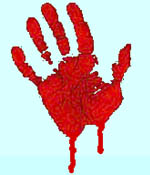 Blood Ritual |
 New America |
| Navigate This Site | |
 | |
| Home | |
| Valentine | |
| Dilling | |
| Talmud | |
| The Rabbis | |
| Supplement | |
| Glossary | |
| Download | |
| Admin | |
Endnotes:
- This and other Come and Hear™ Studies on Talmudic Judaism can be found online:
- http://www.come-and-hear.com/editor
- The Jewish Religion: Its Influence Today by Elizabeth Dilling, complete with all 300 exhibits, can be found online:
- http://www.come-and-hear.com/dilling
- Soncino Babylonian Talmud tractates, with Forewords, Introductions, Glossary, List of Abbreviations, and footnotes. Now you can study the Babylonian Talmud in full context and with the running commentary of the finest scholars of Judaism:
- Tractate Berakoth: http://www.come-and-hear.com/berakoth
- Tractate Shabbath: http://www.come-and-hear.com/shabbath
- Tractate Yebamoth: http://www.come-and-hear.com/yebamoth
- Tractate Kethuboth: http://www.come-and-hear.com/kethuboth
- Tractate Nedarim: http://www.come-and-hear.com/nedarim
- Tractate Nazir: http://www.come-and-hear.com/nazir
- Tractate Sotah: http://www.come-and-hear.com/sotah
- Tractate Gittin: http://www.come-and-hear.com/gittin
- Tractate Baba Kamma: http://www.come-and-hear.com/babakamma
- Tractate Baba Mezi'a: http://www.come-and-hear.com/babamezia
- Tractate Baba Bathra: http://www.come-and-hear.com/bababathra
- Tractate Sanhedrin: http://www.come-and-hear.com/sanhedrin
- Tractate Abodah Zarah: http://www.come-and-hear.com/zarah
- Tractate Horayoth: http://www.come-and-hear.com/horayoth
- Tractate Niddah: http://www.come-and-hear.com/niddah
- Tractate Tohoroth: http://www.come-and-hear.com/tohoroth
- Search the Talmud http://www.come-and-hear.com/tindex.html
- Download all the above resources for local study, CD, or mirror web site:
- http://www.come-and-hear.com/download
Appendix: Deborah Lipstadt Finds Anti-Semitism in the New Testament
On April 8, 1998 on PBS's The NewsHour with Jim Lehrer, a group of prominent persons discussed the Papal apology for what the Pope calls the Catholic Church's silence during the Holocaust. One of the speakers, Deborah Lipstadt, a professor of modern Jewish and Holocaust studies at Emory University, broadened the scope of her remarks from the Vatican to comments on the New Testament generally.
And there are other places — this tends to set this, I think, false dichotomy, speaking as an historian, between anti-Judaism and anti-Semitism and to suggests [sic] that Nazi anti-Semitism was something that grew up ex-Nihilo, out of nothing. In truth, that without the anti-Judaism — much of it anti-Semitism — of the New Testament, or at least in the way the New Testament has been interpreted and taught, there would have been no Nazism, and there would have been no Holocaust. I'm not saying that it was inevitable, but it is a direct outgrowth.
— Deborah Lipstadt (25)
Deborah Lipstadt, who is not a Christian, is free to discuss passages in the New Testament that she considers "anti-Judaism." Five years later, the ADL still features Professor Lipstadt on their website, indicating that ADL does not consider Professor Lipstadt engaged in hate speech. Nor has ADL demanded that Professor Lipstadt, Jim Lehrer, or PBS apologize for Lipstadt's remarks on PBS. However, ADL recently condemned Gentiles who find anti-Gentile quotes in the Talmud. ADL says these Gentiles are using the quotes "to foment anti-Semitism." (17)
According to Deborah Lipstadt, criticism of the Jews (found in the Gospels) reveals anti-Semitism. But according to the ADL, noticing that Gentiles are criticized in the Talmud also reveals anti-Semitism.
If a Jew can speak about anti-Jewish text in Christian Scripture, shouldn't a Gentile be allowed to speak about anti-Gentile text in Jewish Scripture? Americans are used to free give and take. When the ADL closes down open discussion, it creates anti-Semitism. How can that bring about understanding between people of different faiths?
